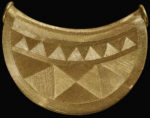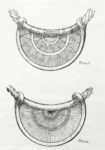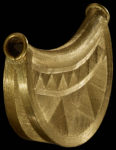 The British Museum has acquired the spectacular Bronze Age gold bulla discovered two years ago in Shropshire. The crescent-shaped pendant, intricately incised with geometric patterns, was found to meet the criteria of the 1996 Treasure Act at an inquest held by the Coroner for Shropshire John Ellery on January 31st, 2019. Once declared Treasure, the object was assessed by the Treasure Valuation Committee which determined its fair market value to be £250,000. With the support of the Art Fund and the American Friends of the British Museum, the museum was able to raise the money to buy what is believed to be one of the most significant Bronze Age metalwork artifacts ever found in the British Isles.
The British Museum has acquired the spectacular Bronze Age gold bulla discovered two years ago in Shropshire. The crescent-shaped pendant, intricately incised with geometric patterns, was found to meet the criteria of the 1996 Treasure Act at an inquest held by the Coroner for Shropshire John Ellery on January 31st, 2019. Once declared Treasure, the object was assessed by the Treasure Valuation Committee which determined its fair market value to be £250,000. With the support of the Art Fund and the American Friends of the British Museum, the museum was able to raise the money to buy what is believed to be one of the most significant Bronze Age metalwork artifacts ever found in the British Isles.
One side shows a stylized sun – a rare and hugely significant addition to the art and iconography of Bronze Age Britain. Solar symbolism is a key element of Bronze Age cosmology and mythology across Europe, but before the discovery of this pendant was very rarely seen on objects found in Britain. […]
The pendant is one of a small number of contemporary, precious objects made to celebrate the religious and life-giving power of the sun during the Bronze Age. They have been found across Europe, including the famous Trundholm Sun Chariot from Denmark and the ‘sun discs’ of North-West Europe.

 It was discovered by a metal detectorist, but both the finder’s identity and that of the landowner are being kept secret, as is the location of the find site, in order to keep the excessively curious off the scent. Archaeologists from the British Museum in collaboration with Trent & Peak Archaeology and University College Cork have investigated the Shropshire site and discovered that the field was a boggy wetland during the Bronze Age. The bulla was likely intentionally thrown into the bog as a votive deposit.
It was discovered by a metal detectorist, but both the finder’s identity and that of the landowner are being kept secret, as is the location of the find site, in order to keep the excessively curious off the scent. Archaeologists from the British Museum in collaboration with Trent & Peak Archaeology and University College Cork have investigated the Shropshire site and discovered that the field was a boggy wetland during the Bronze Age. The bulla was likely intentionally thrown into the bog as a votive deposit.
 Is it 3,000 years old and one of only two Bronze Age bullae ever found in England. The other was discovered near Manchester in 1722 during the dredging of the Irwell ship canal and antiquarians thought the striking geometric decoration was of such high quality it could only be Roman. The Manchester bulla was sold privately in 1806 and hasn’t been seen nor heard from since. Six other broadly parallel bullae have been discovered in northern Ireland. They all range in date between 1000 and 750 B.C., the late Bronze Age.
Is it 3,000 years old and one of only two Bronze Age bullae ever found in England. The other was discovered near Manchester in 1722 during the dredging of the Irwell ship canal and antiquarians thought the striking geometric decoration was of such high quality it could only be Roman. The Manchester bulla was sold privately in 1806 and hasn’t been seen nor heard from since. Six other broadly parallel bullae have been discovered in northern Ireland. They all range in date between 1000 and 750 B.C., the late Bronze Age.
Pendants of this type are called bullae after the Latin for “bubbles” because they are crafted from sheet gold and are hollow inside. The Shropshire  bulla has been X-rayed and CT-scanned to determine what’s inside the tube collar along the top of the pendant. It looks like clay or compacted soil, but it’s still unclear whether it was a deliberate fill or the unintended result of centuries spent underground. Metal analysis has shown the sheet to be approximately 80% gold and 20% silver and copper, an alloy consistent with other late Bronze Age metalwork.
bulla has been X-rayed and CT-scanned to determine what’s inside the tube collar along the top of the pendant. It looks like clay or compacted soil, but it’s still unclear whether it was a deliberate fill or the unintended result of centuries spent underground. Metal analysis has shown the sheet to be approximately 80% gold and 20% silver and copper, an alloy consistent with other late Bronze Age metalwork.
The first public showing of the bulla will take place this November at the Shrewsbury Museum and Art Gallery in Shropshire, near the find site. Additional artifacts recovered during the recent excavation will be displayed alongside the pendant. When it returns to the British Museum, the bulla will go on permanent display near the Mold Gold Cape, an absolute masterpiece of Bronze Age metalwork found in a grave in North Wales in 1833.

